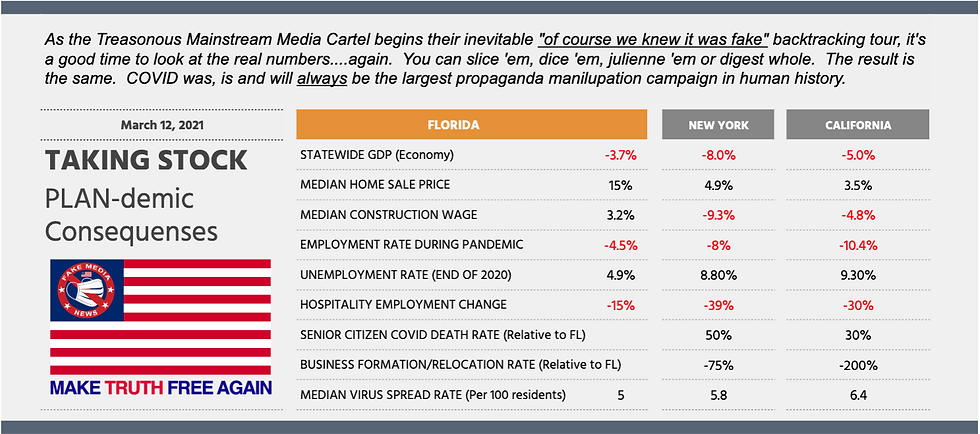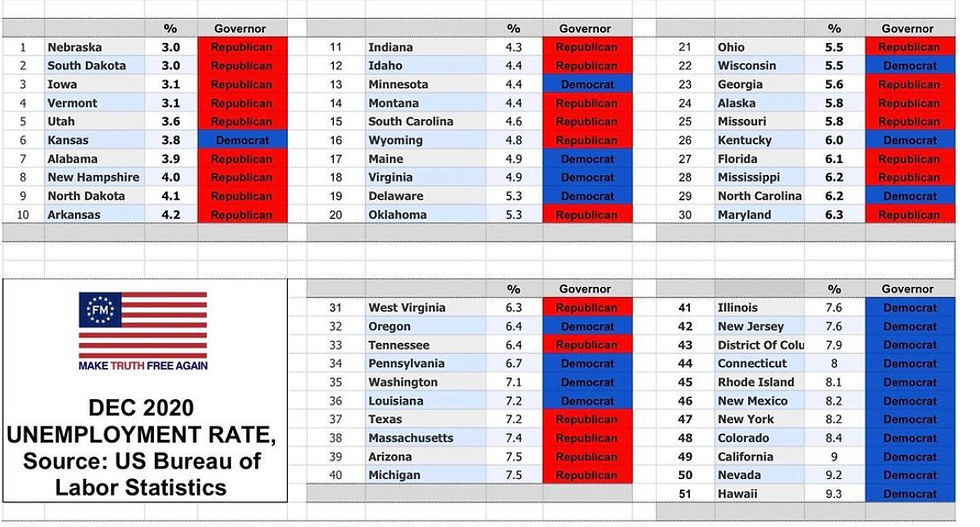WSJ Admits Numbers Don't Lie : COVID Results Vindicate DeSantis, Anti-Lockdown States
- Truth
- Mar 13, 2021
- 7 min read
Add this one to the ever-growing "I told you so" list. The anti-mask, anti-lockdown, anti-Covid hoaxers have been passionate about this from Day one and for good reason. While it may seem, according to the treasonous mainstream media, that these are "new" revelations, they are anything but new. The numbers we are looking at now are no different than the "Science" that we were looking at a year ago. The only difference in the statistics? With a full year of data, we are even MORE sure now than we were last year.
I have no reason whatsoever to sugar-coat this any more. COVID IS A HOAX. Masks are a HOAX. Shutdowns are weaponized, unconstitutional measures taken at the directive of the Left and the World Bank Cabal. They are intended to crash economies, make the common person poor, dejected and distracted from the truth that is out in plain sight. Period.
Don't believe me. You Shouldn't.
But the cracks in the Matrix are everywhere. Even the "intrepid" Wall Street Journal now admits just how how wrong the media's fake "science" was, after all:
March 9, 2021
The media vilified him for rejecting harsh lockdowns. But Florida’s Covid-19 numbers are better than California’s or New York’s, and its economy thrives.

In the early months of the coronavirus pandemic, New York Gov. Andrew Cuomo imposed strict lockdown policies—many still in place—and became the media’s golden boy. “The governor of New York’s morning news conferences have become part of the country’s new daily rhythm,” the Washington Post’s Style section gushed in March 2020. “He’s the strongman who can admit he’s wrong. He speaks fluently about the facts. He worries about his mother, and by extension, yours, too.”
Gov. Ron DeSantis took a different approach and was pilloried. He was among the first to lift his state lockdown, adopting something resembling Sweden’s strategy of protecting the vulnerable while keeping businesses and schools open. “Florida Man Leads His State to the Morgue,” read a June headline in the New Republic. “Ron DeSantis is the latest in a long line of Republicans who made the state a plutocratic dystopia. Now he’s letting its residents die to save the plutocrats.”
A year after the virus hit the U.S., Mr. Cuomo’s luster has faded, and Mr. DeSantis can claim vindication. The Sunshine State appears to have weathered the pandemic better than others like New York and California, which stayed locked down harder and longer.
Mortality data bear out this conclusion. The Covid death risk increases enormously with each decade of age. More than 80% of Covid deaths in the U.S. have occurred among seniors over 65. They make up a larger share of Florida’s population than any other state except Maine. Based on demographics, Florida’s per-capita Covid death rate would be expected to be one of the highest in the country.
Nope. Florida’s death rate is in the middle of the pack and only slightly higher than in California, which has a much younger population. Florida’s death rate among seniors is about 20% lower than California’s and 50% lower than New York’s, based on Centers for Disease Control and Prevention data.
Several Democratic governors, including Mr. Cuomo and New Jersey’s Phil Murphy, early in the pandemic required nursing homes to accept
Covid patients discharged from hospitals, though many were short-staffed and unable to care for them properly. The New York investigation by Attorney General Letitia James estimated that the state’s nursing home deaths were 50% higher than Mr. Cuomo’s official figures, though it’s impossible to know how many deaths his order caused. The Journal reported Thursday that Mr. Cuomo’s aides rewrote a report by state health officials in June to omit the number of New York nursing-home residents who’d died in hospitals during the pandemic.
Mr. DeSantis took a smarter approach. His administration halted outside visitations to nursing homes and bolstered their stockpile of personal protective equipment. Florida’s government also set up 23 Covid-dedicated nursing centers for elderly patients discharged from hospitals. Nursing-home residents who tested positive and couldn’t be isolated in their facilities were sent to these Covid-only wards. Florida set up field hospitals to handle a surge in cases that models predicted in the spring, although it never materialized.
“Those models about hospital overcrowding never even came close to bearing out, even in New York,” Mr. DeSantis says in an interview. “Some of those policies that were done in these other states, they really were motivated by those models. And those models did do a lot of damage.”

Like most governors, Mr. DeSantis shut down most businesses when President Trump issued guidelines for a national lockdown on March 16. “We did the 15 days to slow the spread,” Mr. DeSantis says. The governor kept restrictions on “nonessential” businesses for several more weeks, but he let more places stay open than other states, including child-care facilities, construction sites, hotels and beaches. National media published photos of crowded Florida beaches. “DeSantis in Florida let everybody go crazy over spring break,” CNN’s Chris Cuomo, the New York governor’s brother, said in June. “He then exported all that virus back to wherever—wherever they wanted to go, OK?”
But Florida’s infection rate during April stayed on par with California, where most beaches and residential construction were restricted. “I was not convinced that a lot of those [lockdown] policies were making a huge difference as data came in,” Mr. DeSantis says.
Florida began a phased reopening in early May, allowing restaurants, barbershops, nail salons, gyms and other retailers to operate initially at 50% capacity provided they follow social-distancing and sanitary protocols. Bars and pubs were later allowed to open at 50% capacity, and limits for other businesses were increased.
Mr. DeSantis also let theme parks—important Florida employers and tourist attractions—reopen at reduced capacity. SeaWorld Orlando and Universal Studios reopened in June. “Disney World took a little longer, but that was just because of their [own] business decisions.” California’s government still hasn’t allowed the Disneyland or Universal Studios theme parks to reopen.
Florida’s cases started climbing in June as people socialized more, including at graduation parties, summer cookouts and on Father’s Day. Experts and the media castigated the governor for reopening too fast and too soon. “Despite the guidelines and the recommendations to open up carefully and prudently, some states skipped over those and just opened up too quickly,” the National Institutes of Health’s Anthony Fauci said in July. “Certainly Florida I know, you know, I think jumped over a couple of checkpoints.”

But cases spiked across the Sun Belt, including in California, which maintained much stricter business restrictions. Still, political pressure intensified on Mr. DeSantis to shut down his state again. He refused. “I’m like, ‘No, we’re not going to lock down. It doesn’t work. It compounds problems,’ ” he says. The virus is not “going to be governed by simply closing someone’s business, or not letting people go to work.”
Mr. DeSantis says he listened to a different cast of experts such as Stanford’s Jay Bhattacharya, Harvard’s Martin Kulldorff and Oxford’s Carl Heneghan and Sunetra Gupta. Instead of shutting down businesses in the summer, he ordered more-frequent testing for nursing-home workers and deployed more personnel to hard-hit hospitals. In late July, cases in Florida and across the Sun Belt began to fall.
In September Mr. DeSantis lifted capacity restrictions on restaurants and bars. He also overrode local jurisdictions that tried to keep them closed. “We said every business has the right to operate; you cannot close anything. Everyone has the right to work. You have to let people earn a living,” he says. Mr. DeSantis also required local school districts to offer in-person instruction five days a week in the fall, though parents could choose remote learning instead. “The union sued us, but we beat them in court.”
Teachers unions in large school districts in California, meanwhile, have refused to return to classrooms. They claim schools are unsafe. But per capita Covid cases among children are about the same in Florida and California.
When cases began to rise again in the fall, Democratic governors like Mr. Cuomo and California’s Gavin Newsom tightened business shutdowns and even sought to limit Thanksgiving gatherings to 10 people. Mr. Cuomo griped that police weren’t strictly enforcing his household limits.
The fall and winter lockdowns don’t appear to have made any difference in the virus spread. Between Nov. 1 and Feb. 28, there were 5.8 new cases per 100 people in New York, 6.4 in California, and only 5 in Florida, where businesses could stay open at full capacity. But the economic impact of the lockdowns has been enormous.
Employment declined by 4.6% in Florida in 2020, compared with 8% in California and 10.4% in New York. Leisure and hospitality jobs fell 15% in Florida, vs. 30% in California and 39% in New York.
Florida’s freedom has drawn people and economic activity to the state. It ranked third among “U-Haul Migration Growth States” for one-way rentals. While travel is still lower than it was last year, several airlines including Southwest, Spirit and United have added direct flights to Florida this winter. “The addition of these new flights represents United’s largest expansion of point-to-point, non-hub flying and reflects our data driven approach to add capacity where customers are telling us they want to go,” said Ankit Gupta, the airline’s vice president in charge of domestic scheduling.
The state “had an acceleration of some of the business migration that we’ve seen, particularly in finance,” Mr. DeSantis says. The Hedge Fund Association hosted a webinar last month titled “Capitalizing on South Florida,” highlighting investment firms that had moved to the region.
Mr. DeSantis’s administration counts at least 35 large businesses that have moved to the state since the pandemic began. According to Census Bureau data, Florida’s per capita business formation between April 2020 and January 2021 was twice as high as California’s and 75% higher than New York’s.
Florida’s economy shrank only 3.7% in the third quarter of 2020 from the fourth quarter in 2019, according to data from the Bureau of Economic Analysis, compared with 4.9% for California and 8% for New York. The latter states probably took even bigger economic hits in the fourth quarter when they shut down.
As for tourism, Mr. DeSantis says “the Panhandle had their best summer and best year ever,” thanks to family road trips from nearby states. Orlando has been somewhat slower to bounce back because it relies more on foreign visitors, and international travel has been almost entirely shut down.
Real estate across the state is booming. Home sales increased 20% in the last six months of 2020 year over year, while the median sales price rose 14.4%. Construction wages and salaries during the third quarter were 3.2% higher in Florida year over year but 4.8% lower in California and 9.3% lower in New York. “When you talk to home builders, what they’ll tell me is they’ve had the best year,” Mr. DeSantis says. “They’ve noticed more [people moving] from California than they ever have.”
The lesson of Florida’s Covid success story, according to the governor: “We’ve shown people that you can have a good time, you can be safe, and you can make the decision that’s best for you.” What has Andrew Cuomo learned?
Ms. Finley is a member of the Journal’s editorial board.


Kommentare